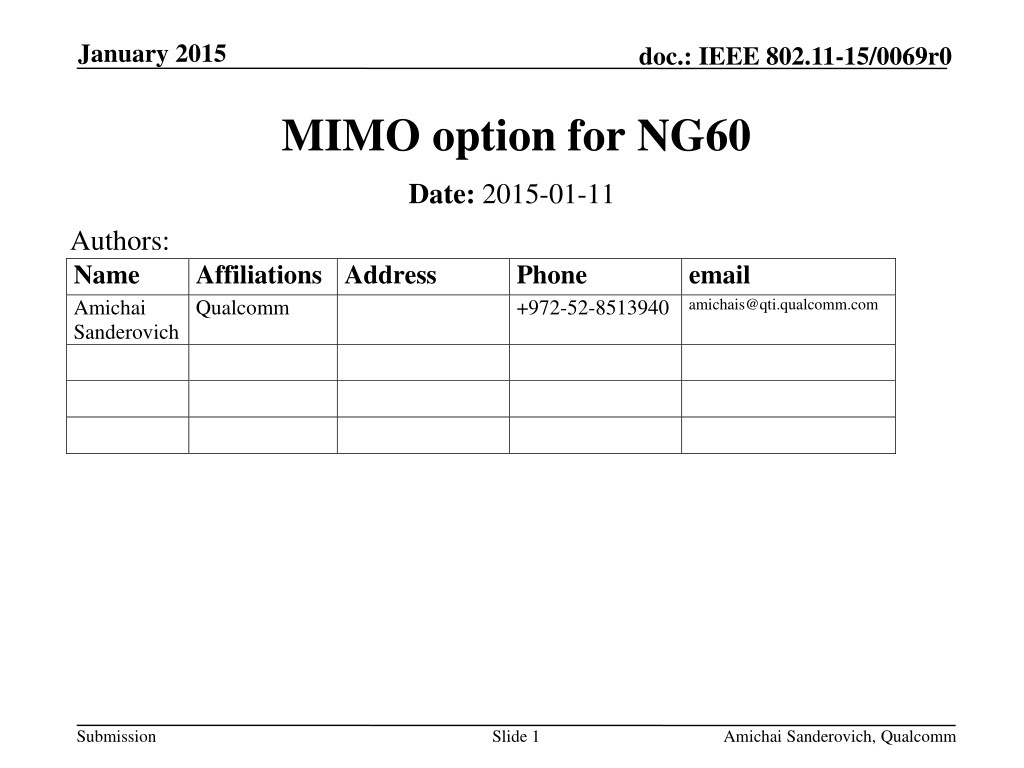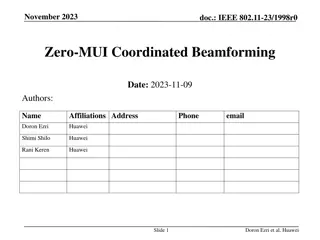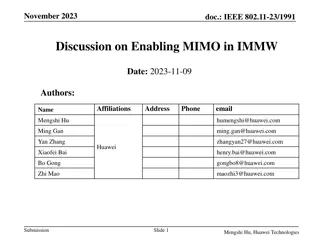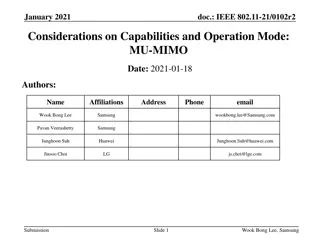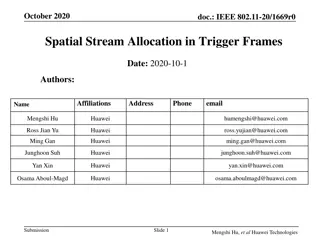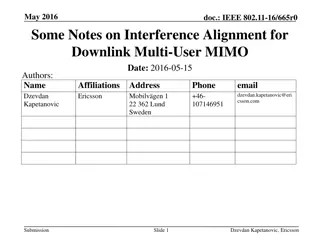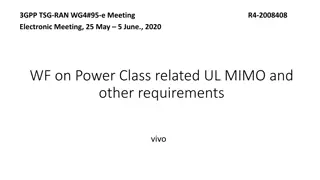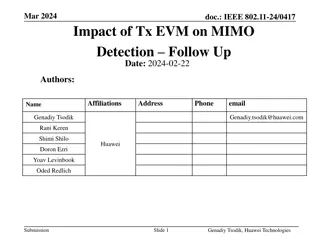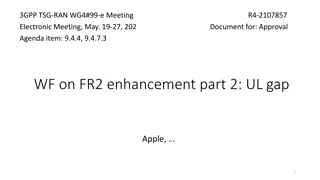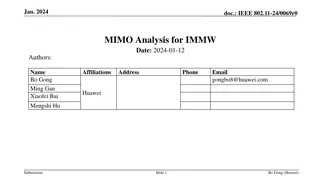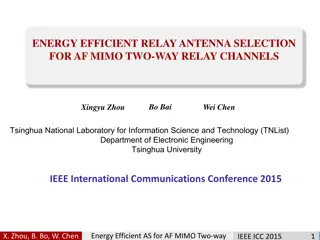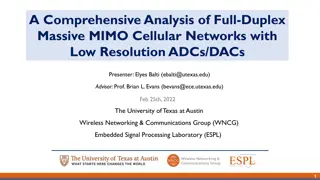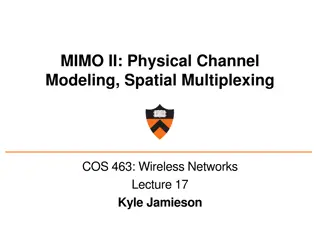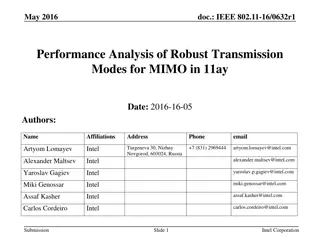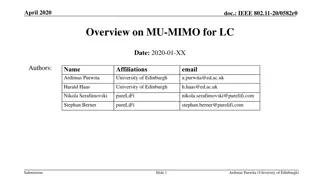MIMO option for NG60
This document discusses a MIMO option for NG60 that allows for increased bit-rate without consuming more bandwidth. The proposed MIMO option works effectively in line-of-sight scenarios based on polarization. Capacity results are presented without delving into implementation details, assuming a practical array setup.
Download Presentation

Please find below an Image/Link to download the presentation.
The content on the website is provided AS IS for your information and personal use only. It may not be sold, licensed, or shared on other websites without obtaining consent from the author.If you encounter any issues during the download, it is possible that the publisher has removed the file from their server.
You are allowed to download the files provided on this website for personal or commercial use, subject to the condition that they are used lawfully. All files are the property of their respective owners.
The content on the website is provided AS IS for your information and personal use only. It may not be sold, licensed, or shared on other websites without obtaining consent from the author.
E N D
Presentation Transcript
January 2015 doc.: IEEE 802.11-15/0069r0 MIMO option for NG60 Date: 2015-01-11 Authors: Name Amichai Sanderovich Affiliations Address Qualcomm Phone +972-52-8513940 email amichais@qti.qualcomm.com Submission Slide 1 Amichai Sanderovich, Qualcomm
January 2015 doc.: IEEE 802.11-15/0069r0 Motivation and purpose NG60 looks for several options to increase bitrate MIMO allows higher bit-rate, without taking more bandwidth MIMO is a simple extension to an exiting antenna array We propose a MIMO option that works well also in LOS based on polarization Capacity results are presented We do not go into implementation details such as coding, constellations, equalizers at this time A practical array is assumed Submission Slide 2 Amichai Sanderovich, Qualcomm
January 2015 doc.: IEEE 802.11-15/0069r0 Setup Single array 8 dual-feed patch elements: Each element can be used with horizontal polarization, vertical polarization, or combined. All vertical feeds and all horizontal feeds are combined to form two spatial streams BB BB Double feed array Data Out Data In Double feed array processing processing Submission Slide 3 Amichai Sanderovich, Qualcomm
January 2015 doc.: IEEE 802.11-15/0069r0 Setup features Setup is based on an existing 802.11ad array with dual polarization Single spatial stream Small FF, for mobile devices Element patterns were measured These measurements are used for two spatial streams in the simulated setup Shannon-capacity is presented, no overheads, Gaussian constellation. 802.11ad devices work ~5 dB from capacity Submission Slide 4 Amichai Sanderovich, Qualcomm
January 2015 doc.: IEEE 802.11-15/0069r0 Simulation features Bore-sight to bore-sight Transmitter/receiver use calibrated sectors for transmitting with horizontal and vertical polarizations Shannon capacity: 1. Closed loop: Transmitter and receiver use singular vectors Exact channel measurement feedback 2. Open loop: Transmitter and receiver use predefined configured sectors Transmitter sends one spatial stream from horizontal-pol and one spatial stream from vertical-pol 3. Double channel: uses the same setup, with double channel 4. SISO: use only single stream, as existing 802.11ad Submission Slide 5 Amichai Sanderovich, Qualcomm
January 2015 doc.: IEEE 802.11-15/0069r0 Resulting channel between streams Difference between horizontal and vertical antenna gains is -1.2 dB Polarization correlation (V-H, and H-V) is -9.5, -13.5 dB 2 70 Close loop MIMO - 1.76GHz Open loop MIMO - 1.76GHz (calibrated sectors) SISO - 1.76GHz Close loop MIMO - 3.92GHz Open loop MIMO - 3.92GHz (calibrated sectors) SISO - 3.92GHz 60 50 Capacity [Gbps] 40 30 20 Close loop MIMO Open loop MIMO 1.9 1.8 1.7 Multiplicity 10 1.6 1.5 1.4 0 1.3 5 10 15 20 25 30 SNR [dB] 5 10 15 SNR [dB] 20 25 30 Submission Slide 6 Amichai Sanderovich, Qualcomm
January 2015 doc.: IEEE 802.11-15/0069r0 Summary Polarization based MIMO was analyzed It provides an effective way to double bit-rate, at modest SNRs Works also for LOS channels Can be done with small arrays A cost-effective way reaching 20Gbps MAC-SAP: double channel, polarization MIMO 2x2 gets 30Gbps for 15 dB SNR Submission Slide 7 Amichai Sanderovich, Qualcomm
